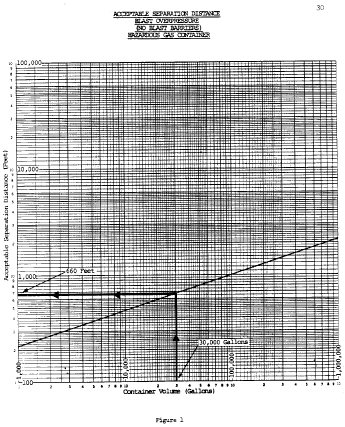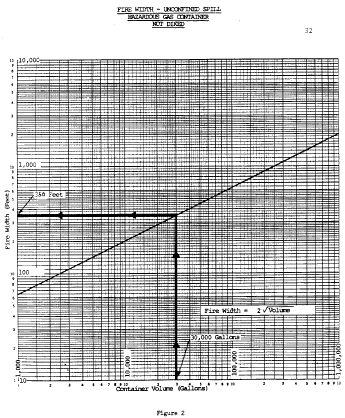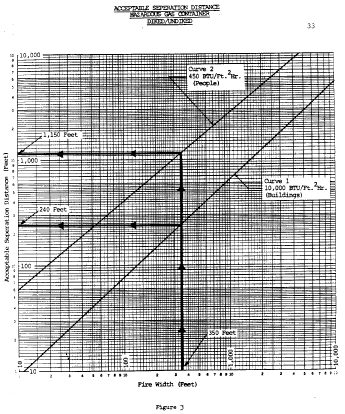Appendix II to Subpart C of Part 51 - Development of Standards; Calculation Methods
24:1.1.1.1.30.3.59.10.5 : Appendix II
Appendix II to Subpart C of Part 51 - Development of Standards;
Calculation Methods I. Background Information Concerning the
Standards
(a) Thermal Radiation:
(1) Introduction. Flammable products stored in above
ground containers represent a definite, potential threat to human
life and structures in the event of fire. The resulting fireball
emits thermal radiation which is absorbed by the surroundings.
Combustible structures, such as wooden houses, may be ignited by
the thermal radiation being emitted. The radiation can cause severe
burn, injuries and even death to exposed persons some distance away
from the site of the fire.
(2) Criteria for Acceptable Separation Distance (ASD).
Wooden buildings, window drapes and trees generally ignite
spontaneously when exposed for a relatively long period of time to
thermal radiation levels of approximately 10,000 Btu/hr. sq. ft. It
will take 15 to 20 minutes for a building to ignite at that degree
of thermal intensity. Since the reasonable response time for fire
fighting units in urbanized areas is approximately five to ten
minutes, a standard of 10,000 BTU/hr. sq. ft. is considered an
acceptable level of thermal radiation for buildings.
People in outdoor areas exposed to a thermal radiation flux
level of approximately 1,500 Btu/ft 2 hr will suffer intolerable
pain after 15 seconds. Longer exposure causes blistering, permanent
skin damage, and even death. Since it is assumed that children and
the elderly could not take refuge behind walls or run away from the
thermal effect of the fire within the 15 seconds before skin
blistering occurs, unprotected (outdoor) areas, such as
playgrounds, parks, yards, school grounds, etc., must be placed at
such a distance from potential fire locations so that the radiation
flux level is well below 1500 Btu/ft 2 hr. An acceptable flux
level, particularly for elderly people and children, is 450 Btu/ft
2 hr. The skin can be exposed to this degree of thermal radiation
for 3 minutes or longer with no serious detrimental effect. The
result would be the same as a bad sunburn. Therefore, the standard
for areas in which there will be exposed people, e.g. outdoor
recreation areas such as playgrounds and parks, is set at 450
Btu/hr. sq. ft. Areas covered also include open space ancillary to
residential structures, such as yard areas and vehicle parking
areas.
(3) Acceptable Separation Distance From a Potential Fire
Hazard. This is the actual setback required for the safety of
occupied buildings and their inhabitants, and people in open spaces
(exposed areas) from a potential fire hazard. The specific distance
required for safety from such a hazard depends upon the nature and
the volume of the substance. The Technical Guidebook entitled
“Urban Development Siting With Respect to Hazardous/Commercial
Industrial Facilities,” which supplements this regulation, contains
the technical guidance required to compute Acceptable Separation
Distances (ASD) for those flammable substances most often
encountered.
(b) Blast Overpressure: The Acceptable Separation
Distance (ASD) for people and structures from materials prone to
explosion is dependent upon the resultant blast measured in pounds
per square inch (psi) overpressure. It has been determined by the
military and corroborated by two independent studies conducted for
the Department of Housing and Urban Development that 0.5 psi is the
acceptable level of blast overpressure for both buildings and
occupants, because a frame structure can normally withstand that
level of external exertion with no serious structural damage, and
it is unlikely that human beings inside the building would normally
suffer any serious injury. Using this as the safety standard for
blast overpressure, nomographs have been developed from which an
ASD can be determined for a given quantify of hazardous substance.
These nomographs are contained in the handbook with detailed
instructions on their use.
(c) Hazard evaluation: The Acceptable Separation
Distances for buildings, which are determined for thermal radiation
and blast overpressure, delineate separate identifiable danger
zones for each potential accident source. For some materials the
fire danger zone will have the greatest radius and cover the
largest area, while for others the explosion danger zone will be
the greatest. For example, conventional petroleum fuel products
stored in unpressurized tanks do not emit blast overpressure of
dangerous levels when ignited. In most cases, hazardous substances
will be stored in pressurized containers. The resulting blast
overpressure will be experienced at a greater distance than the
resulting thermal radiation for the standards set in Section
51.203. In any event the hazard requiring the greatest separation
distance will prevail in determining the location of HUD-assisted
projects.
The standards developed for the protection of people and
property are given in the following table.
|
Thermal radiation |
Blast overpressure |
| Amount of
acceptable exposure allowed for building structures |
10,000 BTU/ft 2
hr |
0.5 psi. |
| Amount of
acceptable exposure allowed for people in open areas |
450 BTU/ft 2
hr |
0.5 psi. |
Problem Example
The following example is given as a guide to assist in
understanding how the procedures are used to determine an
acceptable separation distance. The technical data are found in the
HUD Guidebook. Liquid propane is used in the example since it is
both an explosion and a fire hazard.
In this hypothetical case a proposed housing project is to be
located 850 feet from a 30,000 gallon liquid propane (LPG) tank.
The objective is to determine the acceptable separation distance
from the LPG tank. Since propane is both explosive and fire prone
it will be necessary to determine the ASD for both explosion and
for fire. The greatest of the two will govern. There is no dike
around the tank in this example.
Nomographs from the technical Guidebook have been reproduced to
facilitate the solving of the problem.
ASD For Explosion
Use Figure 1 to determine the acceptable separation distance for
explosion.
The graph depicted on Figure 1 is predicated on a blast
overpressure of 0.5 psi.
The ASD in feet can be determined by applying the quantity of
the hazard (in gallons) to the graph.
In this case locate the 30,000 gallon point on the horizontal
axis and draw a vertical line from that point to the intersection
with the straight line curve. Then draw a horizontal line from the
point where the lines cross to the left vertical axis where the
ACCEPTABLE SEPARATION DISTANCE of 660 feet is found.
Therefore the ASD for explosion is 660 feet
Since the proposed project site is located 850 feet from the
tank it is located at a safe distance with regards to blast
overpressure.

ASD For
Fire
To determine the ASD for fire it will be necessary to first find
the fire width (diameter of the fireball) on Figure 2. Then apply
this to Figure 3 to determine the ASD.
Since there are two safety standards for fire: (a) 10,000 BTU/ft
2 hr. for buildings; and (b) 450 BTU/ft 2 hr. for people in exposed
areas, it will be necessary to determine an ASD for each.
To determine the fire width locate the 30,000 gallon point on
the horizontal axis on Figure 2 and draw a vertical line to
the straight line curve. Then draw a horizontal line from the point
where the lines cross to the left vertical axis where the FIRE
WIDTH is found to be 350 feet.
Now locate the 350 ft. point on the horizontal axis of Figure
3 and draw a vertical line from that point to curves 1 and 2.
Then draw horizontal lines from the points where the lines cross to
the left vertical axis where the ACCEPTABLE SEPARATION DISTANCES of
240 feet for buildings and 1,150 feet for exposure to
people is found.
Based on this the proposed project site is located at a safe
distance from a potential fireball. However, exposed playgrounds or
other exposed areas of congregation must be at least 1,150 feet
from the tank, or be appropriately shielded from a potential
fireball.
(Source: HUD Handbook, “Urban Development Siting With Respect to
Hazardous Commercial/Industrial Facilities.”)


[49 FR 5105, Feb.
10, 1984; 49 FR 12214, Mar. 29, 1984]
 ASD For
Fire
ASD For
Fire

 [49 FR 5105, Feb.
10, 1984; 49 FR 12214, Mar. 29, 1984]
[49 FR 5105, Feb.
10, 1984; 49 FR 12214, Mar. 29, 1984]